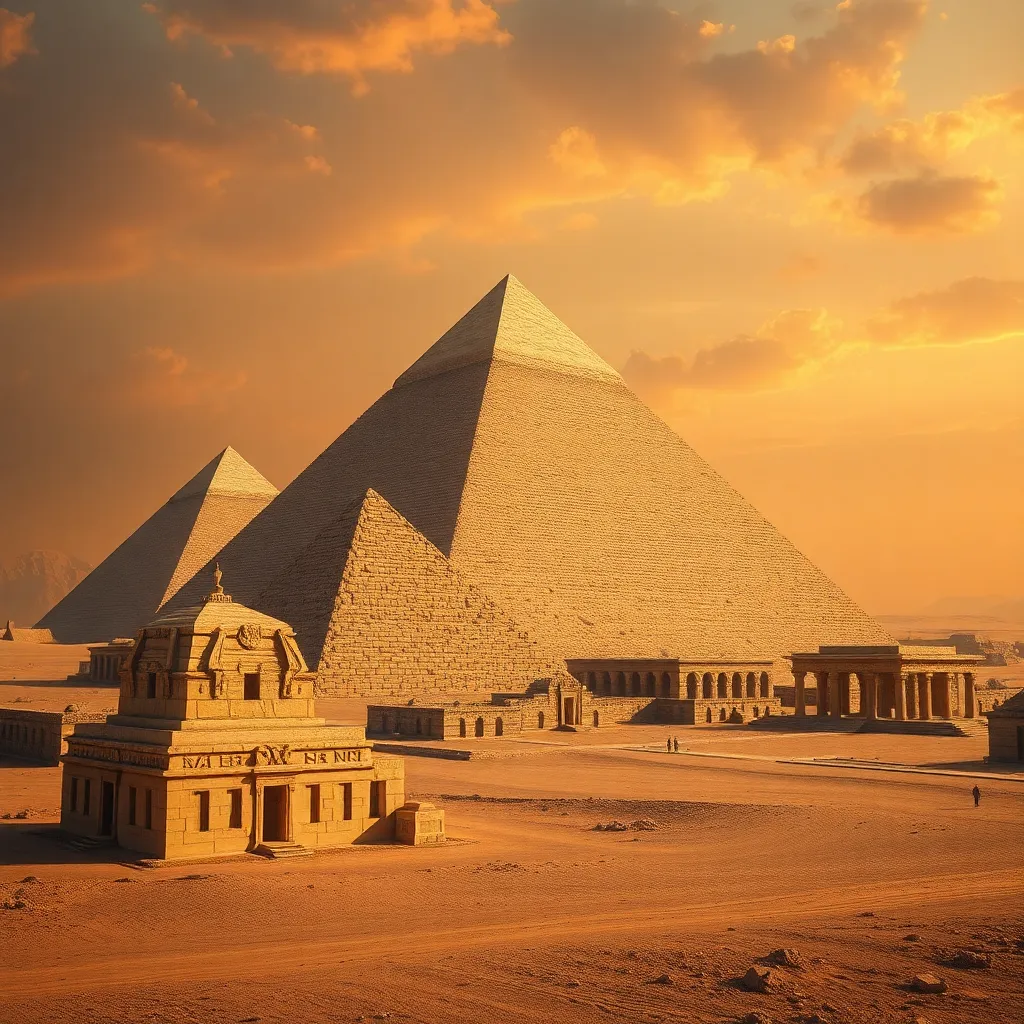The Pyramids and Their Role in Afterlife Beliefs
I. Introduction
The Pyramids of Egypt stand as monumental testaments to the ingenuity and spiritual beliefs of ancient Egyptian civilization. These colossal structures, primarily built as royal tombs, served not only as final resting places for pharaohs but also as gateways to the afterlife. In ancient Egyptian culture, the beliefs surrounding the afterlife were deeply intertwined with the construction and purpose of the pyramids, shaping their significance in society.
This article aims to explore the intricate relationship between the pyramids and ancient Egyptian afterlife beliefs, delving into their historical context, architectural symbolism, burial practices, and the enduring fascination they inspire in modern times.
II. Historical Context of the Pyramids
The construction of the pyramids spans several dynasties, primarily during the Old Kingdom period (c. 2686–2181 BCE). The most notable pyramids, including the Great Pyramid of Giza, were built during the Fourth Dynasty.
- Timeline of Pyramid Construction:
- Step Pyramid of Djoser (c. 2670 BCE)
- Great Pyramid of Khufu (c. 2580–2560 BCE)
- Pyramid of Khafre (c. 2570 BCE)
- Pyramid of Menkaure (c. 2510 BCE)
- Key Figures and Dynasties Involved:
- Pharaoh Djoser: Initiated the step pyramid design.
- Pharaoh Khufu: Commissioned the largest pyramid at Giza.
- Pharaoh Khafre: Built the second pyramid and the Great Sphinx.
- Architectural Advancements and Techniques:
- Use of limestone and granite blocks.
- Advanced surveying techniques.
- Labor organization and workforce management.
III. The Pyramids as Tombs
The primary purpose of the pyramids was to serve as tombs for pharaohs and other elite individuals. These monumental edifices were designed to protect the body and possessions of the deceased for eternity.
- Burial Practices and Rituals:
- Embalming and mummification to preserve the body.
- Rituals performed to ensure safe passage to the afterlife.
- Construction of elaborate burial chambers within the pyramids.
- Notable Pyramids and Their Occupants:
- Great Pyramid of Giza: Tomb of Pharaoh Khufu.
- Pyramid of Khafre: Tomb of Pharaoh Khafre, featuring the Great Sphinx.
- Pyramid of Menkaure: Tomb of Pharaoh Menkaure, smaller yet intricately designed.
IV. Afterlife Beliefs in Ancient Egypt
Ancient Egyptian cosmology is rich with concepts that explain the afterlife, emphasizing the importance of living a virtuous life to achieve eternal existence.
- Overview of Ancient Egyptian Cosmology:
- Belief in multiple gods governing various aspects of life and death.
- The concept of Ma’at, representing truth, balance, and order.
- Concepts of the Afterlife:
- Duat: The underworld where the dead journey after death.
- Field of Reeds: The ideal afterlife realm, a paradise for the righteous.
- Importance of the Ka, Ba, and Akh:
- Ka: The life force that continues after death.
- Ba: The personality that could travel between the living and the dead.
- Akh: The transformed spirit that represents a successful afterlife.
V. Symbolism and Design of the Pyramids
The design of the pyramids is laden with symbolism reflecting ancient Egyptian beliefs about the afterlife and resurrection.
- Architectural Symbolism Related to the Afterlife:
- The pyramid shape represents a stairway to heaven.
- Orientation towards the cardinal points, aligning with celestial bodies.
- Alignment with Celestial Bodies:
- Many pyramids are aligned with the stars, particularly Orion.
- Connection to the sun god Ra, emphasizing rebirth and resurrection.
- The Pyramid Shape as a Resurrection Symbol:
- Represents the rays of the sun and the ascent to the afterlife.
- The pointed top symbolizes the connection between the earth and the divine.
VI. Funerary Goods and Their Role
Funerary goods play a crucial role in Egyptian burial practices, providing the deceased with necessary items for the afterlife.
- Items Buried with Pharaohs:
- Jewelry, weapons, and personal items for protection and comfort.
- Food and drink offerings to sustain the deceased in the afterlife.
- Role of Offerings and Provisions:
- Regular offerings made by priests and family members.
- Importance of ensuring the deceased’s needs were met in the afterlife.
- Texts and Inscriptions:
- The Pyramid Texts: Ancient texts inscribed in tombs, containing spells and prayers.
- Guidance for the deceased in navigating the afterlife.
VII. The Pyramids in Modern Understanding
Modern archaeology has shed light on the construction and significance of the pyramids, enhancing our understanding of ancient Egyptian beliefs about the afterlife.
- Archaeological Discoveries:
- Findings of burial chambers and artifacts that reveal burial practices.
- Insights into the labor force and tools used for construction.
- Interpretation of Pyramid Structures:
- Scholarly debates on the purpose and meaning of pyramid complexes.
- Understanding the socio-political context of pyramid construction.
- Cultural Legacy:
- Pyramids as symbols of ancient Egyptian civilization in modern culture.
- Influence on architecture and spirituality across cultures through history.
VIII. Conclusion
The pyramids of Egypt are not merely architectural wonders but are deeply embedded in the complex tapestry of ancient Egyptian afterlife beliefs. They encapsulate the civilization’s spiritual aspirations, showcasing the interplay between architecture and spirituality. The enduring mystery surrounding these structures continues to fascinate scholars and enthusiasts alike, ensuring that the legacy of the pyramids and their significance in ancient Egyptian culture remains alive.
As we explore the intersection of the physical and spiritual realms through the lens of the pyramids, we gain insight into the profound ways in which ancient Egyptians understood life, death, and the afterlife.




